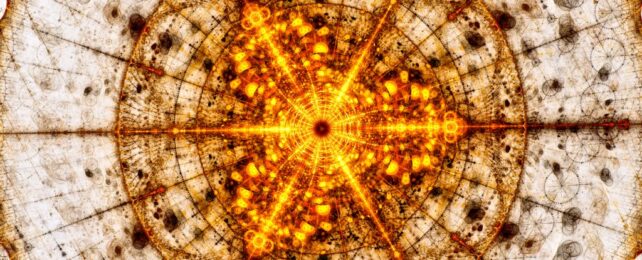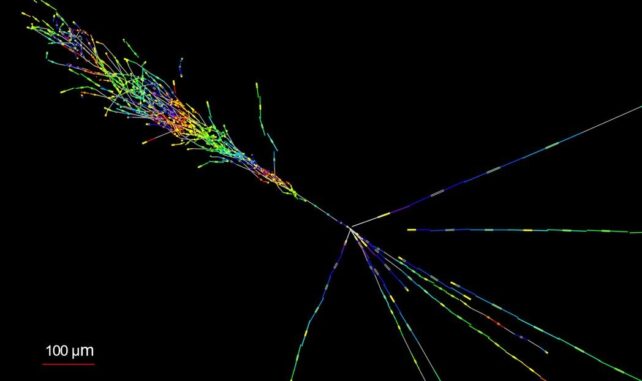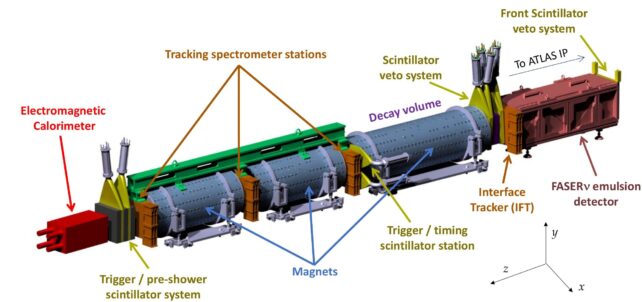 Abstract impression of a particle collider. (sakkmesterke/iStock/Getty Images Plus)
Abstract impression of a particle collider. (sakkmesterke/iStock/Getty Images Plus)Those abundant yet enigmatic subatomic particles are so removed from the rest of matter that they slide through it like specters, earning them the nickname "ghost particles".
The researchers said this work represented the first direct observation of collider neutrinos and would help us to understand how these particles form, what their properties are, and their role in the evolution of the Universe.
The results achieved using the FASERnu detector at the Large Hadron Collider, were presented at the 57th Rencontres de Moriond Electroweak Interactions and Unified Theories conference in Italy back in March 2023.
"We've discovered neutrinos from a brand-new source – particle colliders – where you have two beams of particles smash together at extremely high energy," said particle physicist Jonathan Feng of the University of California Irvine at the time.
Now, two peer-reviewed papers (here and here) have finally published on the detection, making the whole thing a lot more official and exciting.
Neutrinos are among the most abundant subatomic particles in the Universe, second only to photons. But they have no electric charge, their mass is almost zero, and they barely interact with other particles they encounter. Hundreds of billions of neutrinos are streaming through your body right now.

Neutrinos are produced in energetic circumstances, such as the nuclear fusion that takes place inside stars, or supernova explosions. And while we may not notice them on a day-to-day basis, physicists believe that their mass – however slight – probably affects the Universe's gravity (although neutrinos have pretty much been ruled out as dark matter).
Although their interaction with matter is small, it's not completely nonexistent; now and again, a cosmic neutrino collides with another particle, producing a very faint burst of light.
Underground detectors, isolated from other sources of radiation, can detect these bursts. IceCube in Antarctica, Super-Kamiokande in Japan, and MiniBooNE at Fermilab in Illinois are three such detectors.
Neutrinos produced in particle colliders, however, have long been sought by physicists because the high energies involved are not as well studied as low-energy neutrinos.
"They can tell us about deep space in ways we can't learn otherwise," says particle physicist Jamie Boyd of CERN. "These very high-energy neutrinos in the LHC are important for understanding really exciting observations in particle astrophysics."
FASERnu is a emulsion detector consists of millimeter-thick tungsten plates alternated with layers of emulsion film. Tungsten was chosen because of its high density, which increases the likelihood of neutrino interaction; the detector consists of 730 emulsion films and a total tungsten mass of around 1 ton.

During particle experiments at the LHC, neutrinos can collide with nuclei in the tungsten plates, producing particles that leave tracks in the emulsion layers, a bit like the way ionizing radiation makes tracks in a cloud chamber.
These plates need to be developed, like photographic film, before physicists can analyze the particle trails to find out what produced them.
Six neutrino candidates were identified and published back in 2021. Now, the researchers have confirmed their discovery, using data from the third run of the upgraded LHC that began last year, with a significant level of 16 sigma.
That means that the likelihood that the signals were produced by random chance is so low as to be almost nothing; a significance level of 5 sigma is sufficient to qualify as a discovery in particle physics.
The FASER team is still hard at work analyzing data collected by the detector, and it seems likely that many more neutrino detections will ensue. Run 3 of the LHC is expected to continue until 2026, and data collection and analysis are ongoing.
Back in 2021, physicist David Casper of UC Irvine projected that the run would produce around 10,000 neutrino interactions, which means we've barely scratched the surface of what FASERnu has to offer.
"Neutrinos are the only known particles that the much larger experiments at the Large Hadron Collider are unable to directly detect," he says, "so FASER's successful observation means the collider's full physics potential is finally being exploited."
A version of this article was first published in March 2023.






0 Comments